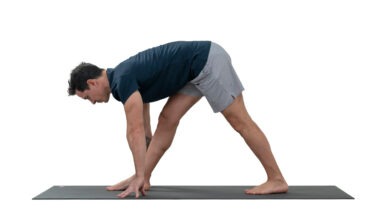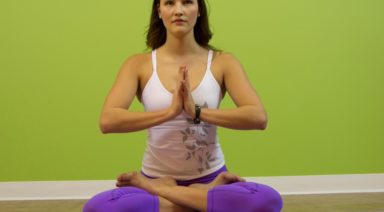Benefits to Practicing Yoga Every Day

In a recent study aptly titled, Neuroprotective Effects of Yoga Practice, the brains of experienced yoga practitioners were compared to those of non-practitioners with similar health profiles. Using magnetic resonance imaging (MRI), researchers at The National Center for Complementary and Integrative Health were able to identify regions of activity and growth. As a result, this study found that:
- A regular practice combining breath awareness, physical postures and meditation can increase the volume of gray matter (brain tissue) in different parts of the brain, effectively reducing the naturally occurring, age-related decline of brain cells. With most of the observed gray matter volume changes having occurred in the left-side of the brain, the implication is that yoga shifts the automatic response of the practitioner from fight-or-flight (right-brain, sympathetic nervous system activation resulting in acute physical stress) to rest-and-digest (left-brain, parasympathetic nervous system activation promoting calm and relaxation)
- The areas of the brain indicating the greatest change in gray matter were those directly related to sense of self, attention, spatial/sensory awareness as well as stress reduction. These findings provide a potential neural basis for the benefits of practicing yoga. The observed benefits were greater in those who practiced more often over a longer period of time supporting the notion that a consistent practice of yoga every day is more effective than an intermittent one
The Science of Sadhana: Positive Gene Expression
In 2013, studies at the University of Oslo offered a unique look inside the cellular structures of the human body to provide real, measurable data on what actually happens to cells when we practice yoga.
The Norwegian research team discovered that various yoga practices immediately impacted the expression of 111 genes, increasing the function of some while decreasing the function of others.
The Science of Sadhana: Increased Interoceptive Awareness
Norman Farb from the University of Toronto conducted a study on interoceptive and exteroceptive attention where he discovered key differences in the location of brain activity resulting from directed attention, either inward or outward.
What Farb encountered in his study was that when participants focused on an external screen (exteroceptive attention), the primary brain activity occurred in the neocortex, the most recent evolution in the human brain which differentiates us from other species and processes sensory information predominantly from external input. On the other hand, when participants were instructed to observe their breath (interoceptive attention), brain activity was heightened in the areas of the brain that bridge the cortex and the limbic system which is much older in terms of evolution, governing basic instincts and primal emotions.
8 Ways to Be Your Own Guru

No matter how we define a teacher or a guru—an expert, an enlightened person, or someone who challenges us to look at our own limiting beliefs—they’re ways we look for wisdom outside of ourselves. These kinds of teachers are no doubt powerful. But the most powerful source of wisdom is within. How do we activate our own inner teacher—our own inner guru—so we always have someone there for guidance and support?
The most powerful source of wisdom is within you. This is what I help every single person I work with realize—that they are infinitely powerful and the only thing getting in the way of that is surface stuff. When we clear the surface, it’s like polishing a rough stone into a diamond. Suddenly, you’re crystal clear, knowing exactly where to go and what to do next.
The most important work I do with people is helping them access their own inner guru. Here are eight ways to access yours:
Talk less, listen more. You can hear or see exactly where to go and what to do next if you give yourself permission to trust the non-verbal part of your brain. We’re all intuitive, and one of the most scientifically proven ways to tap into it is to listen to the non-verbal part of your brain: your body.
Deactivate fear. Fear comes mostly in the form of worrisome thoughts. And these come from the verbal part of our brain—this part of our brain processes less information per second than the non-verbal part of our brain. In other words, worries are “less informed” thoughts.
Lean into peace. Wisdom and truth feel like relief, like a great letting-go. It’s a wonderful sensation of “Ah, this is such a nice place to rest.” Every time one of my clients hears from their inner guru, they feel a sense of great peace and presence.
Trust yourself. Practice trusting yourself with small things, something less consequential where the decision won’t have a huge impact, but a small one. Something like saying no to an invitation to an event you don’t want to go to. Worry and fear says things like, “She’ll be upset if I don’t go,” or “I won’t be invited anymore.” Peace says, “Do what’s right for you, trust yourself, and all will be well.” Usually what happens in these cases is that everything works out, and you end up getting even more invitations because people are drawn to your confidence and self-esteem.
Trust the universe. Practice opting out of doing something just because you think something like “What will happen if I don’t?” Yoga philosophy has a term called Ishvara Pranidhana that basically means surrender to the universe. It doesn’t mean we never do anything, but we can surrender our attachment to achieving a particular outcome, and through that surrender and non-attachment receive something even greater.
Build your intuition. Next time you want to hear from your inner guru and you’ve already listened to your body, listen for words or watch for symbols. I like to imagine a blank slate and ask a question like “What should I do next?” Sometimes I see a symbol. Other times I hear a word or phrase—things like “Rest,” “Play,” or “Go bigger.” Other times an entire scene unfolds.
Trust your body. Intuition is fun and can give us more information, but first and foremost the first line of wisdom is your body. Your body is constantly guiding you, through sensations of tension and angst or ease and presence. Hint: ease and presence usually means “Go this way!”
Lean into grace. Listening to the guidance of your inner guru leads to choices that create a life filled with less striving and more receiving. Taoists introduce us to the concept of Wu Wei, doing without doing. Through heart-centred action and trusting the universe, things happen with ease. Miracles occur. It was either Yogi Bhajan or Wayne Dyer, depending on which source you choose, who said: “I don’t believe in miracles, I depend on them.” It doesn’t matter who said it, it’s a universal truth, and one that you get to experience firsthand when you start listening deep and choosing to believe.
Much love, and good luck!




































